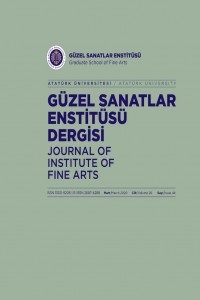Abstract
Fashion is expressed as an action that shapes a thought. It is a term that contains many parameters such as behavior, lifestyle, speaking style, movement, and evaluates all these facts. It diversifies and enriches fashion and fashionable design like place, time, situation, feelings, etc. It will be more descriptive to examine fashion and therefore fashion oriented designs under specific headings rather than individual ones. In this study, information about the technological aspect of fashion will be given and explanations will be made. In this context, the term technical textiles that come first to mind, and covering a wide range of design products stands out. As the name suggests, it is a term used for technical designs. Technical specifications are expected from the designs and functionality is prioritized. An important subclass of technical textiles is the intelligent textile design with electronic circuits and circuit elements. Such designs have the ability to detect and respond to environmental factors. One of the technologies described in this study and which has made significant improvements and progress in recent years is the artificial intelligence technology. Artificial intelligence is the name of the technology required for the development of machines which are created by artificial vehicles without using live organisms and which can exhibit behaviors like human. Using the artificial intelligence technology in the field of fashion, the idea of creating a design by giving the person the ability to think like a human has emerged in the last few years. This trend, which is called virtual fashion, brings with it different designs. Since the work in this area is new, although the human element will not be introduced, the information taught, the learning, the design methods, etc. the human element is needed at points. This causes the design to be directed to a specific point. In this study, information about virtual fashion technology and Project Muze which is one of the first application projects of this technology is given. The relationship between the sample designs and fashion will be discussed and interpreted.
References
- Barthes, R. (1967). The fashion system=[systeme de la mode]. Berkeley: University of California Press.
- Barthes, R. (1997). Gösterge bilimsel serüven. İstanbul: Yapı Kredi Yayınları.
- Çeliksap, S. (1992). Giyside gerçek üstü arayışlar (Yayımlanmamış Yüksek Lisans Tezi). Mimar Sinan Üniversitesi Sosyal Bilimler Enstitüsü, İstanbul.
- Çeliksap, S. (2015). Giyim ve modanın kısa öyküsü. Aydın Sanat, 1, 57–64. Erişim adresi: https://dergipark.org.tr/tr/download/article-file/357980
- Fogg, M. (2014). Modanın tüm öyküsü. (E. Gözgü, Çev.). İstanbul: Hayalperest Yayınevi.
- Read, H. (1974). Sanatın anlamı. İstanbul: İş Bankası Kültür Hizmetleri.
- Turani, A. (2004). Sanat terimleri sözlüğü. İstanbul: Toplum Yayınları.
Abstract
Moda, bir düşünceyi şekillendiren bir eylem (to fashion) olarak ifade edilmektedir. Davranış, yaşam şekli, konuşma tarzı, hareket, vb. birçok parametreyi içinde barındıran ve tüm bu olguları değerlendiren bir terimdir. Yaşanılan yer, zaman, durum, içerisinde bulunulan duygu, vb. birçok parametre, modayı ve modaya uygun olan tasarımı çeşitlendirmekte ve zenginleştirmektedir. Modayı ve dolayısıyla modaya yön veren tasarımları bireysel ele almaktansa belirli başlıklar altında incelemek daha açıklayıcı olacaktır. Bu çalışmada modanın teknoloji yönü hakkında bilgiler verilecek ve açıklamalarda bulunulacaktır. Bu kapsamda akla ilk gelen ve tasarım ürünleri arasında geniş bir yer kaplayan teknik tekstiller terimi ön plana çıkmaktadır. Adından da anlaşılacağı üzere teknik tasarımlar için kullanılan bir terimdir. Tasarımlardan teknik özellikler beklenmektedir ve fonksiyonellik ön planda tutulmaktadır. Teknik tekstillerin önemli bir alt sınıfı ise içerisinde elektronik devrelerin ve devre elemanlarının bulunduğu akıllı tekstil tasarımlarıdır. Bu tür tasarımlar çevresel etkenleri algılama ve istenirse cevap verme yeteneklerine sahiptirler. Bu çalışmada açıklanan ve son yıllarda önemli gelişmeler ve ilerlemeler kaydedilen teknolojilerden birisi de yapay zekâ teknolojisidir. Yapay zekâ, canlı organizmalar kullanılmaksızın yapay araçlar ile oluşturulan, insan gibi davranışlar sergileyebilen makinelerin geliştirilebilmesi için gereken teknolojinin adıdır. Moda alanında yapay zekâ teknolojisi kullanılarak, makinaya insan gibi düşünme yeteneği kazandırılarak tasarım üretilmesi fikri son birkaç yılda ortaya çıkmıştır. Sanal moda olarak isimlendirilen bu akım farklı tasarımları da beraberinde getirmektedir. Bu alanda çalışmalar yeni olduğundan her ne kadar insan unsuru devreye girmeyecek olsa da öğretilen bilgilerde, öğrenmede, tasarım oluşturma yöntemlerinde, vb. noktalarda insan unsuruna ihtiyaç duyulmaktadır. Bu da tasarımın belirli bir noktaya yönlendirilmesine neden olmaktadır. Bu çalışmada sanal moda teknolojisi ve bu teknolojinin ilk uygulama projelerinden birisi olan Project Muze hakkında bilgiler verilmektedir. Örnek tasarımların moda ile olan ilişkisi ele alınacak ve yorumlanacaktır.
Keywords
References
- Barthes, R. (1967). The fashion system=[systeme de la mode]. Berkeley: University of California Press.
- Barthes, R. (1997). Gösterge bilimsel serüven. İstanbul: Yapı Kredi Yayınları.
- Çeliksap, S. (1992). Giyside gerçek üstü arayışlar (Yayımlanmamış Yüksek Lisans Tezi). Mimar Sinan Üniversitesi Sosyal Bilimler Enstitüsü, İstanbul.
- Çeliksap, S. (2015). Giyim ve modanın kısa öyküsü. Aydın Sanat, 1, 57–64. Erişim adresi: https://dergipark.org.tr/tr/download/article-file/357980
- Fogg, M. (2014). Modanın tüm öyküsü. (E. Gözgü, Çev.). İstanbul: Hayalperest Yayınevi.
- Read, H. (1974). Sanatın anlamı. İstanbul: İş Bankası Kültür Hizmetleri.
- Turani, A. (2004). Sanat terimleri sözlüğü. İstanbul: Toplum Yayınları.
Details
| Primary Language | Turkish |
|---|---|
| Journal Section | Articles |
| Authors | |
| Publication Date | March 19, 2020 |
| Submission Date | January 8, 2020 |
| Published in Issue | Year 2020 Volume: 26 Issue: 44 |
Obtaining permissions for studies requiring ethics committee approval regarding the implementation of ethical rules and including information about permission in the article was added to the criteria. In this direction, Ethics Committee Permission is required for articles submitted to our journal and meeting the conditions stated below.
• Any research conducted with qualitative or quantitative approaches that require data collection from participants using questionnaires, interviews, focus group work, observation, experimentation, and interview techniques.
Also;
• Obtaining and indicating permission from the owners for the use of scales, surveys and photographs belonging to others,
• It should be stated that the copyright regulations are complied with for the intellectual and artistic works used.


